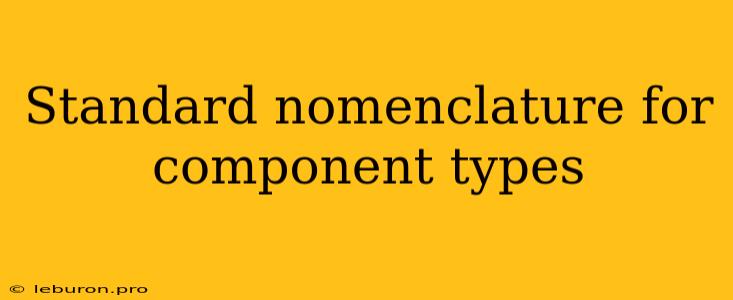In the realm of engineering and manufacturing, precise and consistent communication is paramount. To ensure clarity and avoid ambiguity, a standardized system for identifying and classifying components is essential. This is where standard nomenclature for component types comes into play, providing a universal language for describing the various parts that make up complex assemblies. By adopting a standardized nomenclature, engineers, designers, and manufacturers can effectively communicate their ideas and ensure that components are correctly identified, selected, and used throughout the product development lifecycle. This article delves into the importance of standard nomenclature for component types, exploring its benefits and outlining key considerations for establishing and implementing such a system.
The Importance of Standard Nomenclature for Component Types
Standard nomenclature for component types serves as a cornerstone for effective communication and collaboration within the engineering and manufacturing industries. It provides a structured framework for:
1. Component Identification and Classification
Standard nomenclature for component types facilitates unambiguous identification and classification of components, regardless of their specific design or function. By adopting a consistent system, engineers can easily differentiate between a bearing, a shaft, a gear, or any other component type. This eliminates potential confusion and ensures that everyone involved in the project is working with the same understanding.
2. Accurate Documentation and Data Management
Standard nomenclature for component types is crucial for accurate documentation and data management. By using standardized names and descriptions, engineers can create comprehensive and easily searchable databases of components, ensuring that all relevant information is readily accessible. This facilitates efficient design and manufacturing processes, as well as seamless communication across different departments and stakeholders.
3. Simplified Sourcing and Procurement
Standard nomenclature for component types streamlines sourcing and procurement processes. With standardized component names and specifications, manufacturers can easily search for and identify suitable parts from various suppliers. This reduces the risk of ordering incorrect components, minimizing delays and ensuring that the right parts are readily available when needed.
4. Enhanced Collaboration and Interoperability
Standard nomenclature for component types fosters collaboration and interoperability between different engineering and manufacturing teams. By adopting a shared language for component description, engineers can seamlessly exchange designs, specifications, and manufacturing data. This facilitates effective communication and promotes the use of interchangeable components, minimizing the risk of compatibility issues.
5. Improved Design and Manufacturing Processes
Standard nomenclature for component types simplifies design and manufacturing processes. By adopting a standardized approach to component identification and classification, engineers can easily select and integrate appropriate components into their designs. This ensures that the chosen components meet the specified requirements and optimize the overall design and manufacturing process.
Establishing a Standard Nomenclature System
Establishing an effective standard nomenclature for component types requires careful planning and consideration. Key factors to consider include:
1. Scope of the Nomenclature System
The first step is to define the scope of the nomenclature system. This involves identifying the types of components to be included and the level of granularity required. For example, the system may cover a specific range of mechanical components, such as bearings, shafts, gears, or it might encompass a broader spectrum, including electrical, electronic, and hydraulic components.
2. Hierarchical Structure
A hierarchical structure is crucial for organizing and classifying components. This involves creating a tree-like structure with different levels of detail, starting from the most general category and branching down to more specific subcategories. For example, the top-level category might be "Mechanical Components," followed by subcategories like "Bearings," "Shafts," and "Gears." Each subcategory can be further subdivided into more specific types, such as "Ball Bearings," "Roller Bearings," and "Thrust Bearings."
3. Naming Conventions
Consistent naming conventions are essential for a clear and unambiguous system. This involves defining a set of rules for creating component names, ensuring that they are descriptive, concise, and easily understood. For example, the name "Bearing-Ball-6000-Series" clearly identifies the component type, its specific sub-type, and its size, making it easily recognizable and searchable.
4. Coding System
A coding system can be used to further organize and differentiate components. This involves assigning unique codes to each component type, facilitating easy identification and retrieval. The codes can be based on the component's classification, material, dimensions, or other relevant characteristics.
Implementing and Maintaining a Standard Nomenclature System
Once a standard nomenclature for component types is established, it's essential to ensure its successful implementation and ongoing maintenance. Key considerations include:
1. Communication and Training
Effective communication and training are crucial for successful adoption. All stakeholders, including engineers, designers, manufacturers, and suppliers, should be informed about the new nomenclature system and its benefits. Training sessions can help users understand the system's structure, naming conventions, and coding system.
2. Database Integration
The nomenclature system should be integrated into existing databases and systems. This ensures that all component data is consistently labeled and stored, facilitating efficient data management and search capabilities.
3. Regular Review and Updates
The standard nomenclature for component types should be reviewed and updated regularly to reflect changes in technology, industry standards, and internal practices. This ensures that the system remains relevant and effective in the long term.
Conclusion
Standard nomenclature for component types is an indispensable tool for enhancing communication, collaboration, and efficiency in engineering and manufacturing. By adopting a standardized system, organizations can create a common language for component description, enabling seamless information sharing and promoting accurate data management. Implementing a well-structured nomenclature system significantly improves design, manufacturing, and procurement processes, ultimately contributing to the development of high-quality products. As the complexity of products and manufacturing processes continues to increase, standard nomenclature for component types will play an increasingly vital role in ensuring the success of future engineering and manufacturing endeavors.
